About 80% of adults will experience lower back pain at some point in their lives. For many, it becomes a recurring problem that disrupts daily activities, limits movement, and drains energy.
The good news is that you don’t need expensive treatments or hours at the gym to find relief.
A strong, stable core is the key to a pain-free back. Your core muscles act like a natural support system for your spine. When they’re weak, your back muscles work overtime to compensate. That leads to strain, tension, and pain.
Research backs this up. A 2022 study in The Spine Journal found that people who did 10- to 15-minute core exercises five days a week saw major drops in pain and disability within six weeks. That’s less time than your morning coffee routine.
These exercises are simple. No special equipment needed. Just you, a mat, and 10 minutes a day to build a stronger, pain-resistant back.
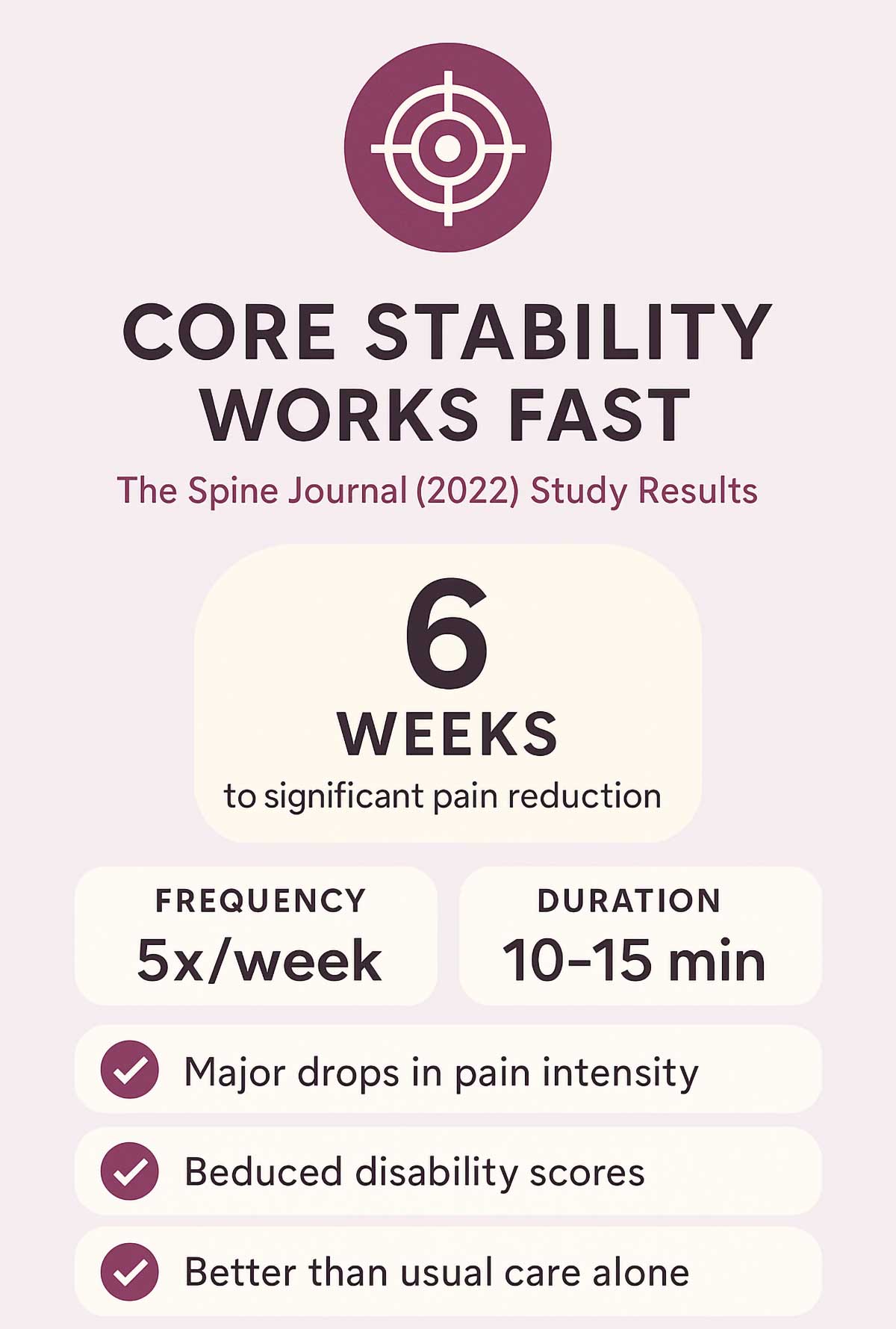
Quick Facts About Lower Back Pain
| Category | Details |
|---|---|
| Affects | 80% of adults at some point in their lives |
| Time Needed | 10 minutes daily |
| Equipment | None (just a mat) |
| Results Timeline | 2-6 weeks with consistent practice |
| Best For | Sedentary workers, fitness enthusiasts, chronic pain sufferers |
| Success Rate | 90% of acute back pain resolves with conservative treatment |
Back Pain Assessment
Answer 6 quick questions to get personalized exercise recommendations
Why Core Stability Matters: What Science Tells Us
Your core isn’t just your abs. It includes dozens of muscles that wrap around your torso like a built-in support belt. The deepest layer, your transverse abdominis, acts like a corset. Your multifidus muscles run along your spine. Your glutes anchor your pelvis.
When these muscles work together, they stabilize your spine during movement. They protect your lower back when you bend, twist, lift, or carry things.
But here’s the problem. These stabilizing muscles often become weak or inhibited in people with back pain. Research shows they literally stop firing correctly. Your brain forgets how to use them.
A 2019 meta-analysis in Clinical Rehabilitation examined 29 different studies on motor control exercises for back pain. The results were clear. People who did these stabilization exercises reduced their pain by 3.1 points on a 10-point scale compared to those who did minimal intervention. That’s a 31% reduction in pain.
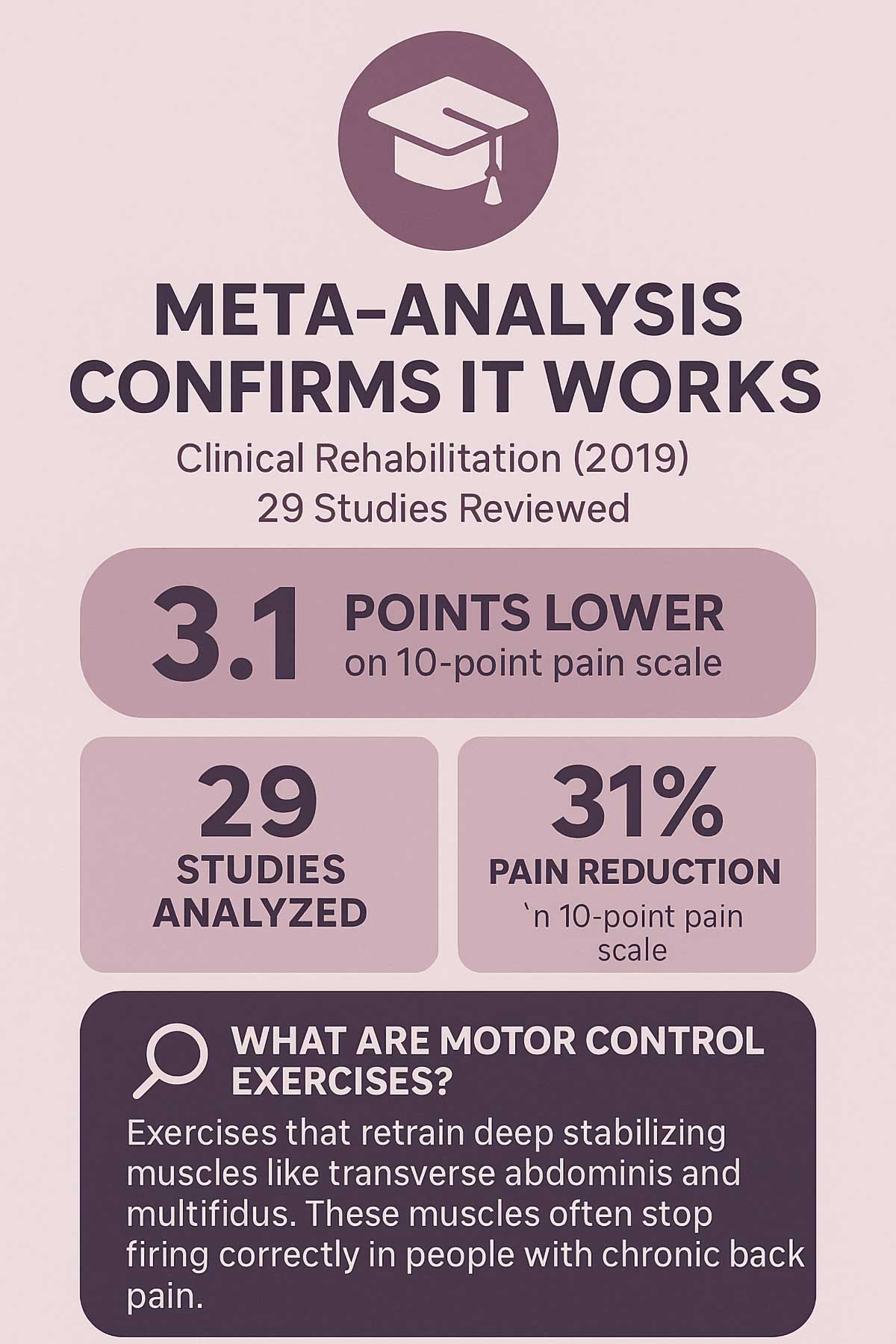
Research from the European Spine Journal in 2019 followed 120 adults with mechanical low-back pain. Those who performed 10 to 12 minutes of trunk-stability exercises daily showed a 35% decrease in pain severity after just eight weeks. The control group, who received standard care without targeted exercises, improved by only 12%.
The difference? Targeted exercises that retrain these stabilizing muscles.
Desk workers face even higher risks. Studies show that people who sit for more than six hours daily have 2.5 times the risk of developing chronic back pain. Poor posture, weak cores, and tight hip flexors create the perfect storm for injury.
But movement is medicine. Short, consistent exercise routines can reverse these effects. Let’s look at the seven exercises that will transform your back.
1. The Foundation of a Strong Back: Bird-Dog
This exercise is your starting point. It builds core stability without putting any stress on your spine. The bird-dog teaches your abs to engage while your arms and legs move. That’s exactly what your body needs to protect your back during everyday tasks.
Muscles targeted: Core (transverse abdominis, rectus abdominis), lower back (erector spinae), glutes, shoulders
How to do it:
Start on all fours. Place your hands directly under your shoulders. Your knees should be under your hips.
Pull your belly button toward your spine. This engages your core.
Extend your right arm straight forward. At the same time, stretch your left leg straight back.
Hold for 5 seconds. Keep your hips and shoulders level. Don’t let them twist or tilt.
Return to the starting position. Switch sides and repeat.
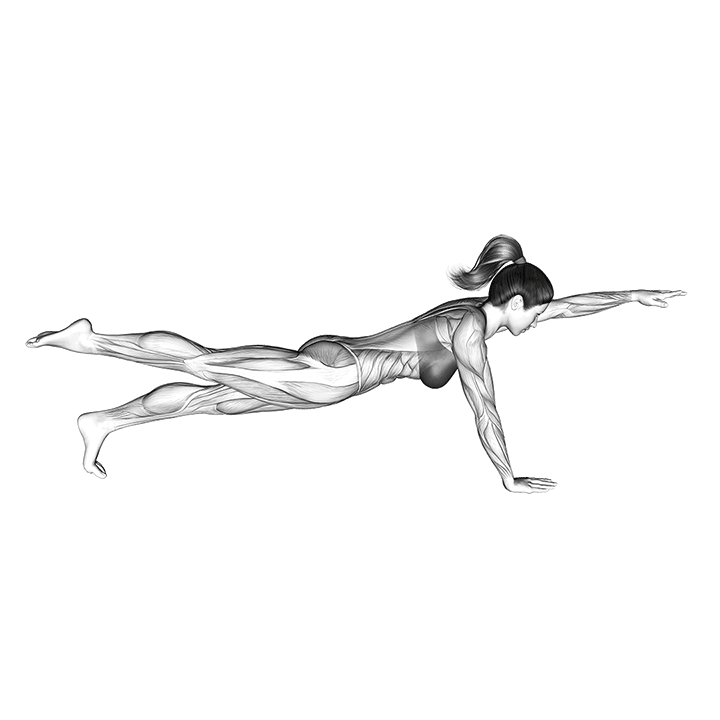
Pro Tip: Picture a glass of water sitting on your lower back. Don’t spill it. This mental trick helps you keep your torso stable and aligned.
2. The Ultimate Core Stabilizer: The Plank
The plank strengthens your deep core muscles. These include the transverse abdominis. Think of it as your body’s built-in back brace. When this muscle is strong, it wraps around your middle like a corset. That gives your spine solid support.
Muscles targeted: Core (transverse abdominis, rectus abdominis, obliques), shoulders, glutes, lower back
How to do it:
Lie on your stomach. Place your forearms on the floor. Your elbows should be directly under your shoulders.
Lift your hips off the ground. Create a straight line from your head to your heels.
Squeeze your core and glutes. Don’t let your hips sag or pike up.
Hold for 20 to 30 seconds. Keep breathing steadily.
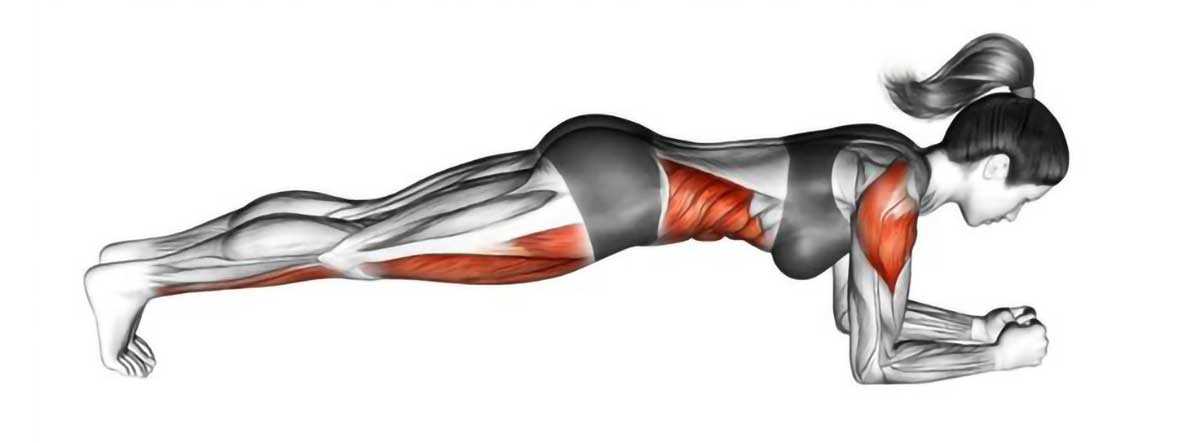
Modification for beginners: Too hard? Drop to your knees. You’ll still work your core but with less intensity.
A 2020 study published in the Journal of Orthopaedic & Sports Physical Therapy tracked 80 participants with chronic back pain. One group did core endurance exercises for 15 minutes, three times weekly. The other group only stretched. After eight weeks, the core group reported 42% less pain and could perform daily tasks with greater ease. The plank was a key component of their routine.
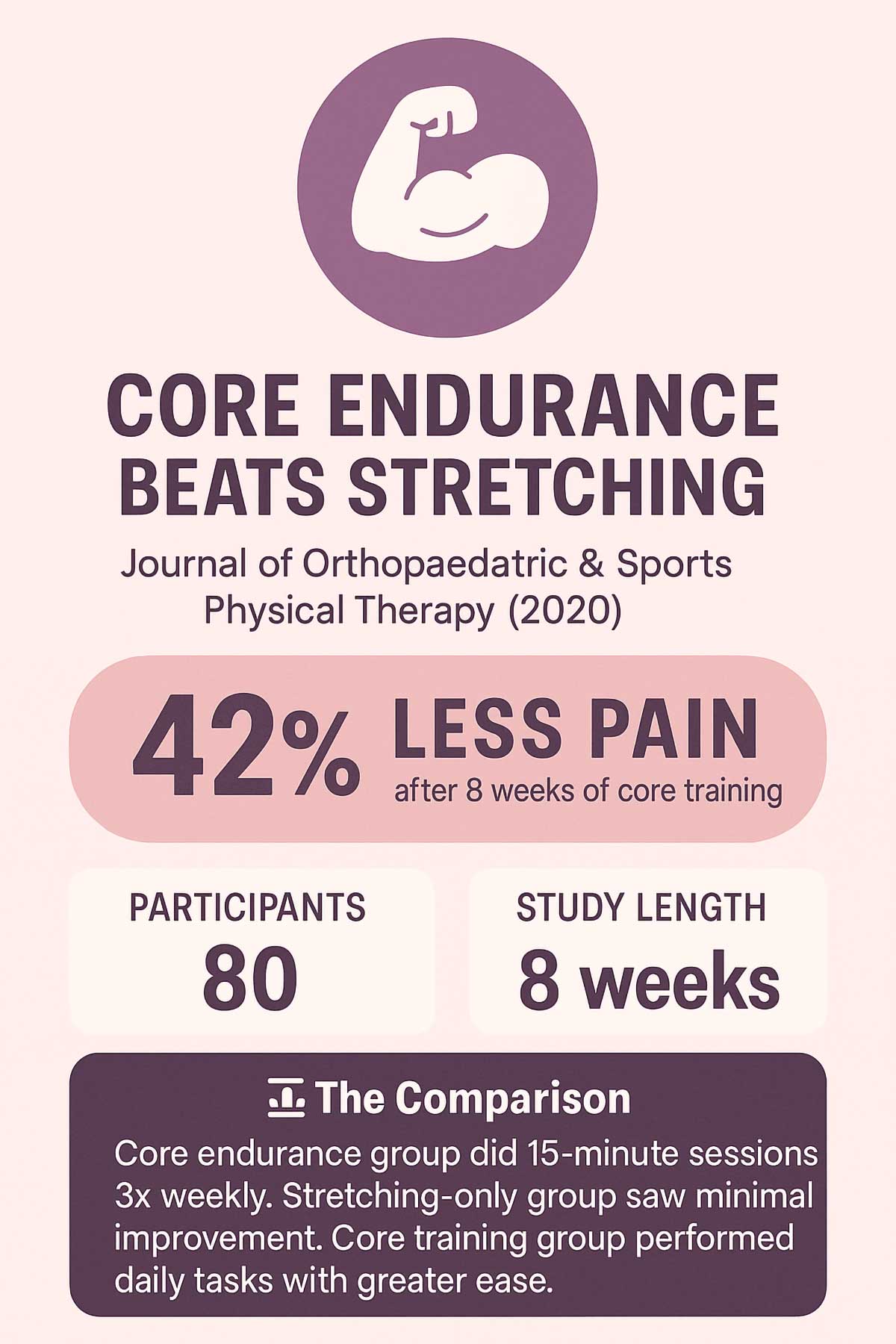
3. The Glute Activator: The Glute Bridge
Weak glutes are a hidden cause of back pain. When your glute muscles don’t do their job, your back muscles pick up the slack. That leads to overwork and injury.
The glute bridge wakes up these powerful muscles. Your glutes support your pelvis and lower back. Making them stronger takes pressure off your spine.
Muscles targeted: Glutes (maximus, medius), hamstrings, core, lower back
Studies in The Spine Journal have shown a clear link between weak glutes and chronic low-back pain. Research indicates that about 70% of people with recurring back pain have underactive glute muscles. Strengthening them can break that cycle.
How to do it:
Lie on your back. Bend your knees and place your feet flat on the floor. They should be hip-width apart. Rest your arms at your sides.
Engage your core. Squeeze your glutes hard as you lift your hips toward the ceiling.
Your body should form a straight line from your shoulders to your knees.
Hold for 3 to 5 seconds. Then slowly lower your hips back down.
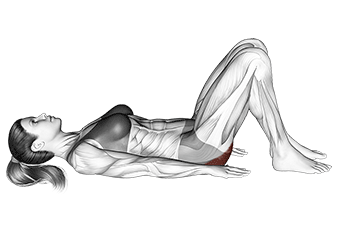
4. The Gentle Decompressor: Cat-Cow Stretch
This dynamic stretch gets your spine moving. It increases flexibility and releases tension in your lower back muscles. The cat-cow is perfect for warming up before strength work or cooling down after.
Muscles targeted: Entire spine (erector spinae), abs, neck, shoulders
How to do it:
Start on all fours.
Breathe in as you drop your belly toward the floor. Lift your head and look up. This is Cow.
Breathe out as you round your spine toward the ceiling. Tuck your chin to your chest. This is Cat.
Flow smoothly between the two positions for 30 to 60 seconds. Move with your breath.
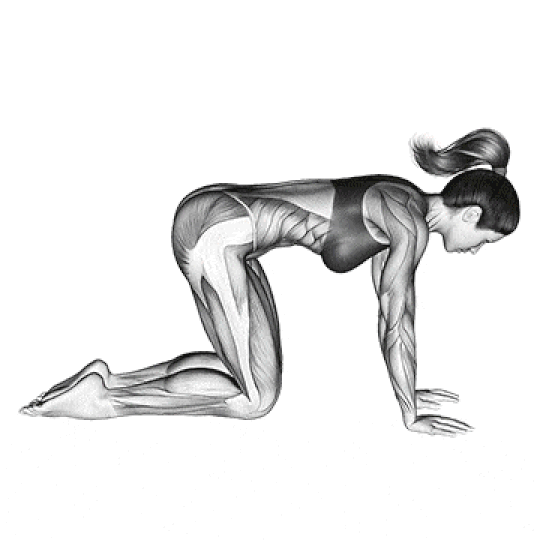
5. The Tension Reliever: Knee-to-Chest Stretch
This simple stretch lengthens your lower back muscles. Many people feel instant relief from tightness and tension. It’s gentle enough to do any time your back feels stiff.
Muscles targeted: Lower back (erector spinae), glutes, hip flexors
How to do it:
Lie on your back with your knees bent. Keep your feet flat on the floor.
Gently pull one knee toward your chest. Hold it with both hands.
Hold for 20 to 30 seconds. You should feel a mild stretch in your lower back and hip.
Repeat with the other leg.
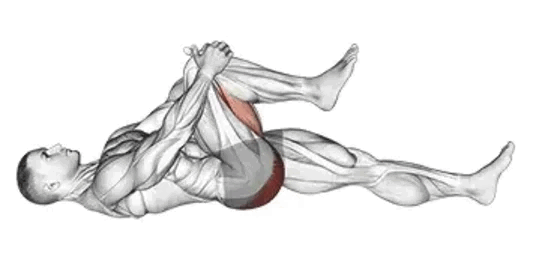
6. The Rotational Mobilizer: Supine Twist
Most people with back pain have limited rotation in their spine. This stretch helps restore that mobility. It also gently stretches your glutes and the muscles along your sides.
Muscles targeted: Obliques, lower back, glutes, hip rotators
How to do it:
Lie on your back. Bend your knees and place your feet flat on the floor.
Extend your arms out to the sides. Your body should form a “T” shape.
Let both knees fall gently to one side. Keep your shoulders flat on the floor.
Hold for 20 to 30 seconds. Feel the stretch along your spine and hip.
Repeat on the other side.
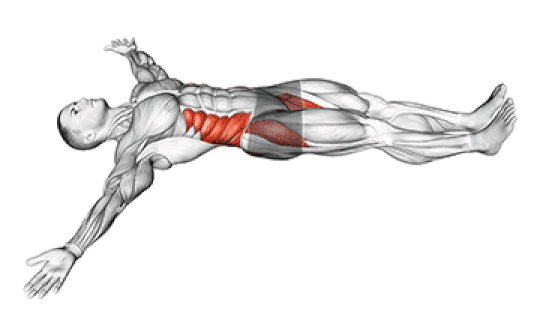
A 2023 study in Frontiers in Physiology examined 60 adults aged 40 to 60 with sedentary jobs. Participants did 10-minute daily mobility and stabilization drills for six weeks. The results? Improved spinal flexibility and reduced pain scores. The researchers noted that consistent, short sessions were more effective than longer, infrequent workouts.
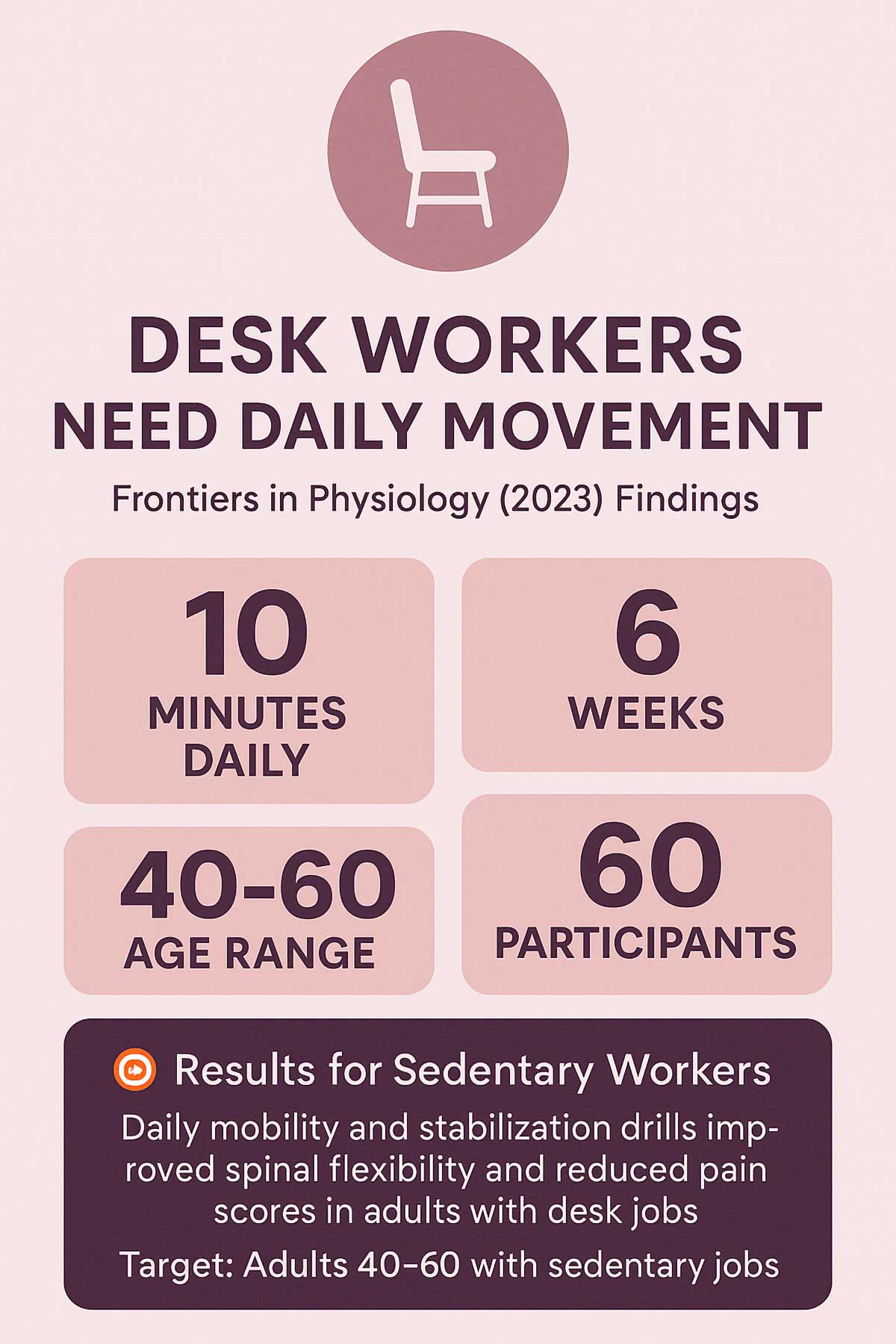
7. The Active Recovery Pose: Child’s Pose
Child’s Pose is your reset button. This restorative position gently stretches your entire back. It reaches from your neck all the way down to your tailbone. It’s the perfect way to end your routine. Your muscles can relax. Your mind can unwind.
Muscles targeted: Lower back, lats, shoulders, hips
How to do it:
Start on all fours.
Sit back on your heels. Fold forward and extend your arms in front of you. Or rest them alongside your body if that feels better.
Rest your forehead on the floor. Take slow, deep breaths.
Hold for 30 to 60 seconds. Let gravity do the work.
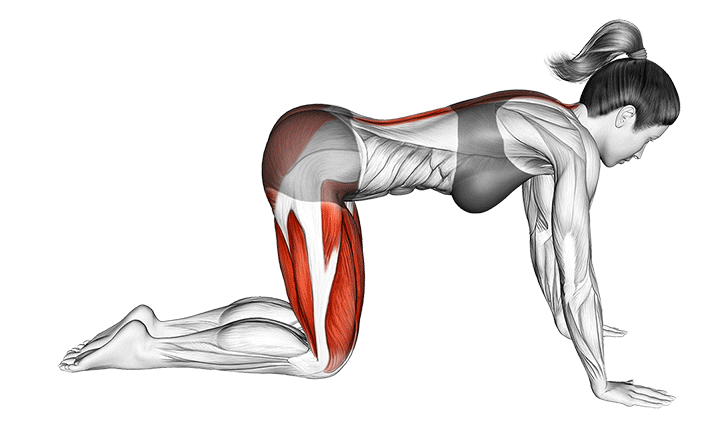
Your 10-Minute Daily Routine to a Pain-Resistant Back
You have the exercises. Now let’s put them together into a simple routine you can do every day.
Warm-up (1 minute):
- Cat-Cow Stretch: 60 seconds
Strengthening Circuit (6 minutes):
- Bird-Dog: 10 reps per side
- Plank: 30-second hold
- Glute Bridge: 15 reps
- Repeat the entire circuit twice
Cool-down (3 minutes):
- Knee-to-Chest Stretch: 30 seconds per leg
- Supine Twist: 30 seconds per side
- Child’s Pose: 60 seconds
That’s it. Ten minutes. You can do this before work. During your lunch break. Or before bed. Pick a time that works for you and stick with it.
The exercises in this routine aren’t random. Each one addresses a specific weakness linked to lower back pain. The bird-dog and plank target core stabilizers that research shows are often inhibited in people with chronic pain. The glute bridge activates muscles that studies prove are underactive in 70% of back pain sufferers. The stretches address mobility restrictions documented in clinical trials. This evidence-based approach gives you the best chance of success.
10-Minute Back Workout
Follow along with audio cues and visual guidance
Today's Routine
Common Mistakes to Avoid
Even simple exercises can lose their effectiveness if done wrong. Here’s how to stay on track.
| Exercise | Common Mistake | Fix |
|---|---|---|
| Bird-Dog | Rotating hips or shoulders | Keep a mirror nearby; check alignment |
| Plank | Sagging hips or raised bottom | Engage glutes; think “straight line” |
| Glute Bridge | Arching lower back at top | Squeeze glutes, not back muscles |
| Cat-Cow | Moving too fast | Sync with breath; 3-5 seconds each pose |
| Knee-to-Chest | Pulling too aggressively | Use gentle pressure; stretch shouldn’t hurt |
| Supine Twist | Forcing knees to floor | Let gravity do the work; stay relaxed |
| Child’s Pose | Holding tension in shoulders | Actively relax; let your body be heavy |
What to Expect: Your Progress Timeline
Consistency matters more than intensity. Here’s what most people experience when they stick with this routine.
| Week | What to Expect | Progression Tips |
|---|---|---|
| 1-2 | Getting comfortable with movements; may feel sore | Focus on form over speed; soreness is normal |
| 3-4 | Movements feel easier; less morning stiffness | Hold plank for 45 seconds; increase bridge reps to 20 |
| 5-6 | Noticeable pain reduction; better posture | Add 5 reps to bridges; 15 bird-dogs per side |
| 7-8 | Significant improvement; increased confidence | Try side planks; single-leg bridges |
| 9-12 | Pain episodes less frequent; stronger overall | Add dead bugs; consider resistance bands |
Research from the European Spine Journal showed that people who did 10- to 12-minute trunk-stability exercises daily had 35% less pain after eight weeks. They also had stronger cores. The key is consistency.
You don’t need to be perfect. Some days you might skip the second round of the circuit. That’s okay. Doing something is always better than doing nothing.
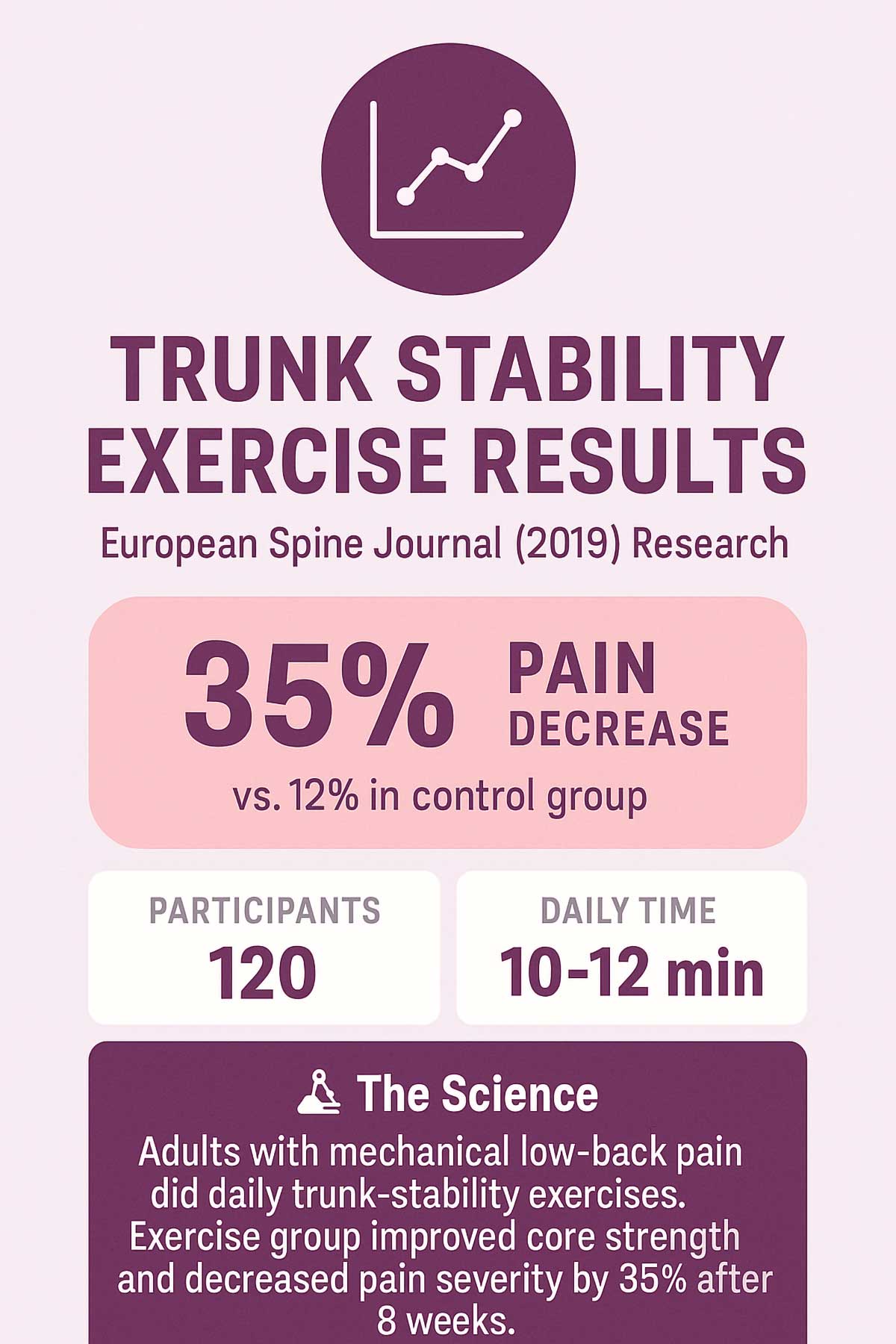
Desk Worker’s Quick Relief Strategy
If you spend most of your day sitting, you need extra support. A 2021 study in BMJ Open Sport & Exercise Medicine examined 95 office workers who spent more than six hours daily at a desk. Participants who incorporated 10-minute posture-reset breaks five days a week experienced a 48% reduction in perceived back pain over eight weeks. They also reported better body awareness and caught themselves slouching less often.
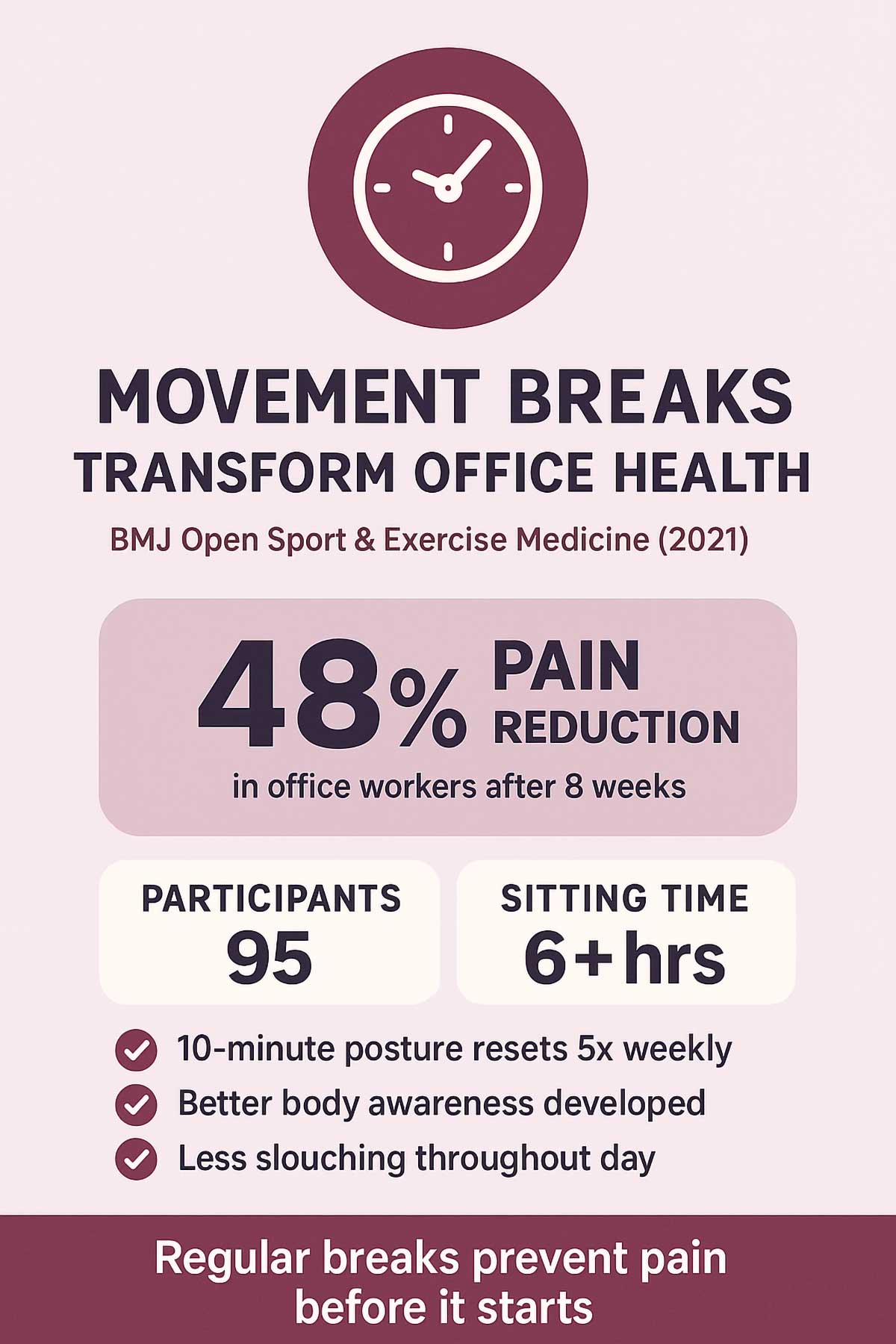
Here’s how to spread your back care throughout the day:
| Time of Day | Quick Exercise | Duration |
|---|---|---|
| Morning (before work) | Full 10-minute routine | 10 min |
| Mid-morning | Cat-Cow at desk or standing | 1 min |
| Lunch break | Glute bridges + Child’s Pose | 3 min |
| Mid-afternoon | Seated spinal twist | 1 min |
| Evening | Full routine or stretches only | 5-10 min |
These mini-sessions break up long periods of sitting. They remind your body how to move. They keep your core muscles engaged throughout the day.
Building Your Pain-Resistant Back
Think of your core like the foundation of a house. When the foundation is weak, cracks appear in the walls. Doors don’t close right. Things start to break down.
Your spine is the same. When your core muscles are weak, your back takes the hit. It bears weight it wasn’t designed to carry alone. Over time, that leads to pain and injury.
These seven exercises work together to build that foundation. The bird-dog and plank create stability. The glute bridge activates muscles that support your pelvis. The stretches keep your spine flexible and release tension.
But exercise is just one piece of the puzzle. Your daily habits play a huge role in back health.
Lifestyle Factors That Support a Healthy Back
You can do these exercises perfectly and still struggle with pain if other areas of your life work against you.
Ergonomics Matter
Your workspace setup can make or break your back health. Your desk height, chair support, and monitor position all affect your posture.
Your computer screen should be at eye level. Your elbows should bend at 90 degrees when typing. Your feet should rest flat on the floor. Your lower back should have support from your chair.
Small adjustments make big differences. A 2021 study found that office workers who improved their workspace setup along with doing daily movement breaks had 63% better outcomes than those who only exercised.
Sleep Position Counts
You spend about a third of your life sleeping. Your position matters.
Side sleeping with a pillow between your knees keeps your spine aligned. It takes pressure off your lower back. Back sleeping works too if you put a pillow under your knees.
Avoid stomach sleeping. It forces your neck to twist and can strain your lower back.
Your mattress matters too. A medium-firm mattress supports most people best. Too soft and you sink. Too firm and pressure builds up.
Hydration Affects Your Spine
Your spinal discs are about 80% water. These discs act as cushions between your vertebrae. When you’re dehydrated, they can’t do their job as well.
Drink water throughout the day. A good rule is half your body weight in ounces. If you weigh 160 pounds, aim for 80 ounces of water daily.
Weight Management Reduces Strain
Extra weight adds pressure to your spine. Each extra pound you carry adds about four pounds of pressure to your lower back.
Losing even 5-10 pounds can make a noticeable difference in pain levels. These exercises help by building muscle. Muscle burns more calories at rest than fat does.
Stress Creates Tension
Stress causes your muscles to tighten up. Many people hold tension in their back and shoulders without realizing it.
Your mind and body are connected. Mental stress shows up as physical tension. That tension can trigger or worsen back pain.
Deep breathing helps. So does regular movement. These exercises also serve as a form of moving meditation. They give you 10 minutes to focus on your body and leave stress behind.
Pain vs. Soreness: Know the Difference
Your body talks to you. Learning its language helps you stay safe.
| Normal Muscle Soreness | Pain (Stop Exercising) |
|---|---|
| Dull, achy feeling | Sharp, stabbing sensation |
| Both sides of body | One-sided only |
| Improves with gentle movement | Worsens with movement |
| Peaks 24-48 hours after exercise | Immediate or sudden onset |
| Goes away within 2-3 days | Persists beyond 3 days |
| Feels like tired muscles | Feels like something is wrong |
Muscle soreness after starting a new routine is normal. It means you’re working muscles that haven’t been active. That soreness should fade as your body adapts.
Pain is different. It’s sharp or shooting. It stops you in your tracks. It makes you worry something is wrong.
Trust that feeling. If an exercise causes pain, stop. Try a modified version. Or skip it and focus on the stretches.
Warning Signs: When to Stop and Seek Help
Most lower back pain improves with these exercises. But some situations need medical attention right away.
Stop immediately and contact a doctor if you experience:
- Pain radiating down both legs
- Loss of bladder or bowel control
- Numbness in the groin area
- Pain after trauma or fall
- Pain accompanied by unexplained weight loss
- Pain with fever or chills
- Weakness in your legs
- Pain that wakes you from sleep regularly
These symptoms can indicate serious conditions that need prompt medical care. They’re rare, but you need to know the warning signs.
Also seek professional help if:
- Your pain lasts more than 6 weeks despite consistent exercise
- Your pain is getting worse instead of better
- You have numbness or tingling that doesn’t go away
- You’re over 50 with new-onset pain (important to rule out serious conditions)
- You have a history of cancer, osteoporosis, or immune disorders
Who Should Be Extra Cautious
These exercises are safe for most people. But some situations require extra care or medical clearance first.
Talk to your doctor before starting if you have:
- Recent spinal surgery (within 6 months)
- Active spinal infection
- Severe osteoporosis
- Pregnancy (you may need modifications)
- Acute injury or recent trauma to your back
Your doctor can help you determine if these exercises are right for you. They might suggest modifications or alternatives.
Make It a Habit: Strategies That Work
The best exercise routine is the one you’ll actually do. Ten minutes is short enough that you won’t dread it. But long enough to make a real difference.
Here’s how to make it stick.
Use Habit Stacking
Attach your new routine to something you already do every day. “After I brush my teeth in the morning, I’ll do my back routine.” This makes it easier for your brain to remember.
Research from the European Journal of Social Psychology found that it takes an average of 66 days to form a habit. Some habits form faster. Some take longer. The key is showing up consistently.
Create Visual Cues
Keep your mat rolled out in a visible spot. Put your workout clothes where you’ll see them first thing.
Out of sight means out of mind. Make it easy to remember by making it visible.
Start with Micro-Commitments
Tell yourself you’ll just do the warm-up. Once you’re on the mat doing cat-cow, you’ll likely complete the whole routine.
This trick works because starting is the hardest part. Once you’re moving, momentum carries you through.
Beyond the Basics: Progressing Your Routine
After 6-8 weeks, you might be ready for more challenge. Your body adapts to exercise. What once felt hard becomes easy. That’s when you progress.
Advanced Variations to Try:
Side Planks These target your obliques more than regular planks. They also challenge your balance. Start with 15-20 seconds per side.
Single-Leg Glute Bridges Lift one leg off the floor during your bridge. This increases the work on your standing leg. It also improves balance and addresses strength imbalances.
Dead Bug Exercise Lie on your back with arms straight up. Knees bent at 90 degrees. Slowly lower opposite arm and leg toward the floor while keeping your back flat. This teaches anti-extension core control.
Pallof Press with Resistance Band Stand sideways to a resistance band anchor point. Hold the band at chest height. Press your hands away from your chest while resisting the pull of the band. This builds anti-rotation strength.
Equipment to Consider:
You don’t need equipment to start. But these tools can add variety:
- Resistance bands: Add challenge to glute bridges and enable Pallof presses
- Stability ball: Makes planks more difficult by adding an unstable surface
- Yoga block: Place between knees during bridges to increase glute activation
- Light dumbbells: Hold during bird-dogs for added difficulty (2-5 pounds)
Only add equipment after you’ve mastered the basics. Form always comes before adding resistance.
Conclusion
You’ve spent enough time dealing with back pain. You’ve tried heating pads, pain relievers, and hoping it would just go away on its own. Those might help in the short term. But they don’t fix the root problem.
A weak core is the root problem for most people with recurring back pain. These seven exercises target that weakness head-on. They build the strength and stability your spine needs to stay healthy.
You now have everything you need:
- Seven proven exercises backed by research
- A simple 10-minute daily routine
- Progression strategies for long-term growth
- Lifestyle tips to support your efforts
- Warning signs to watch for
- Answers to common questions
The science is clear. Short, consistent exercise routines work. Studies show 35-48% pain reduction in just 6-8 weeks. Those aren’t just numbers. That’s real relief. That’s being able to play with your kids without worry. That’s gardening without paying for it the next day. That’s sleeping through the night.
Your back pain doesn’t have to be permanent. You have the power to change it.
Try this routine for two weeks. Just 10 minutes a day. Notice how your back feels when you wake up. Notice how long you can sit without discomfort. Notice how you move throughout your day.
Track your progress. Celebrate small wins. Be patient with setbacks. Building strength takes time. But every rep matters. Every day you show up matters.
FAQs
Can I do these exercises if I have a herniated disc?
Many people with disc issues can safely do these exercises. But you should consult your doctor or physical therapist first. They can assess your specific situation and recommend modifications. Some positions might need to be avoided depending on where your disc problem is located.
Should I do these exercises when my back is actively hurting?
Gentle movement often helps. Start with the stretches only if you’re in significant pain. Skip the strengthening exercises. As your pain decreases, add the strengthening moves back in. If pain worsens during any exercise, stop immediately.
How long before I see results?
Most people notice some improvement within 2-3 weeks. Significant changes typically occur by week 6-8. Your timeline depends on several factors. How long you’ve had pain matters. Your consistency matters most. Daily practice beats occasional longer sessions.
Can I do these exercises twice a day?
Yes, if your body feels good. Just listen to your recovery needs. More isn’t always better if you’re tired or sore. Morning and evening sessions work well for many people. Morning sessions loosen you up for the day. Evening sessions release accumulated tension.
What if I can’t hold a plank for 30 seconds?
Start where you are. Hold for 10-15 seconds. Or do it from your knees. Build up gradually. Add 5 seconds each week. You’ll be surprised how quickly you progress. Consistent short holds build more strength than occasional long holds.
Will these exercises make my back pain go away completely?
These exercises build a more resilient, pain-resistant back. That means fewer pain episodes and less severe pain when it does occur. But they can’t guarantee you’ll never have back pain again. Life happens. You might lift something awkwardly or sleep in a bad position. The goal is to reduce frequency and severity while building your body’s ability to recover quickly.
Can I do these if I have sciatica?
Many people with sciatica find relief from these exercises. But sciatica has different causes. Some respond well to these movements. Others need different approaches. If your leg pain is worse than your back pain, talk to a doctor before starting. That pattern can indicate nerve involvement that needs professional assessment.
Should I stop my other activities while doing this routine?
No. Keep doing activities you enjoy. This routine supports your other activities by building a stronger foundation. If something causes pain, modify or avoid it temporarily. But don’t become sedentary. Movement is medicine. Variety is good for your body.
Medical Disclaimer: This article is for informational purposes only and does not constitute medical advice. Consult with a healthcare professional before starting any new exercise program, especially if you have existing health conditions, chronic pain, or have experienced recent injury. The exercises described are general recommendations and may not be appropriate for everyone.


